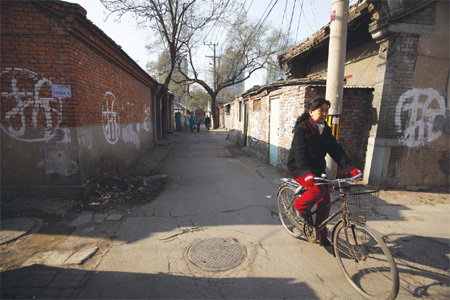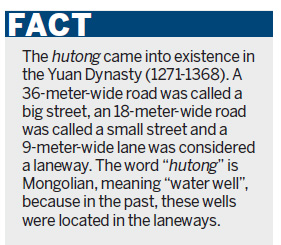Street fighters
Updated: 2010-12-17 10:35
By Liu Lu (China Daily European Weekly)
Protests over hutong demolition force local governments to back down
Two elderly men chat in the middle of a small alleyway as they hold their songbird cages; a boy sits on a bench waiting for a haircut; a cobbler hunches over a pair of worn-out shoes, a group of pipe-smoking men circle around a checker board waiting for the next move.
And the smells of the neighbors' dinner waft through the air of this narrow hutong, or alleyway.
The maze-like hutong of Beijing have been bustling with life for centuries and news of their demise has been a common story over the past decade, as the capital transforms into one of the most important and modern metropolises in the world.
But the speed of their demolition this year has caused hot debate.
 |
|
About 1,000 hutong remain in Beijing and many have been saved, but |
In 1949 there were 3,050 hutong in Beijing and by the late 1980s there were 2,250 as the capital expanded upwards as well as outwards, according to the Urban Planning Society of Beijing. Today, an estimated 1,000 remain.
Many Beijingers consider the remaining hutong as symbols of the old capital and are protesting strongly against any more demolitions. This month a local Beijing government showed it was listening.
|
|
Eighty-four-year-old Hou Changzhong is relieved his hutong neighborhood, in which he has lived for almost five decades, has been saved.
Since January, people living in Hou's neighborhood, known as Gulou (Drum Tower), have been anxiously counting down the days to move out after the Dongcheng district government announced major redevelopment plans.
The hutong area, which surrounds the city's famous Drum and Bell Towers, was to be turned into a tourist attraction called Beijing Time Cultural City, an underground complex comprising car parking lots, shops, restaurants and a museum.
At least five hutong neighborhoods were to be bulldozed and thousands of residents relocated.
The development plan triggered great debate and conservationists, concerned about the future of courtyard houses dating back to the Yuan Dynasty (1271-1368), lobbied the local government more than ever before.
"The removal of the surrounding hutong will undermine the historical and cultural landscape of the Bell Tower area, leaving us with only two ancient buildings and a discordant modern neighborhood," says Zhang Pei, project officer with the Beijing Cultural Heritage Protection Center.
She considers cultural heritage protection more than just looking after a few isolated landmarks, but also about protecting the neighborhoods around them because they are "closely related to each other".
Following the public outcry, Dongcheng district government announced on Dec 3 it would reduce the original construction plan by building only a museum and no additional hutong demolition was required.
E-paper

Ear We Go
China and the world set to embrace the merciful, peaceful year of rabbit
Preview of the coming issue
Carrefour finds the going tough in China
Maid to Order
Specials

Mysteries written in blood
Historical records and Caucasian features of locals suggest link with Roman Empire.

Winning Charm
Coastal Yantai banks on little things that matter to grow

New rules to hit property market
The State Council launched a new round of measures to rein in property prices.

